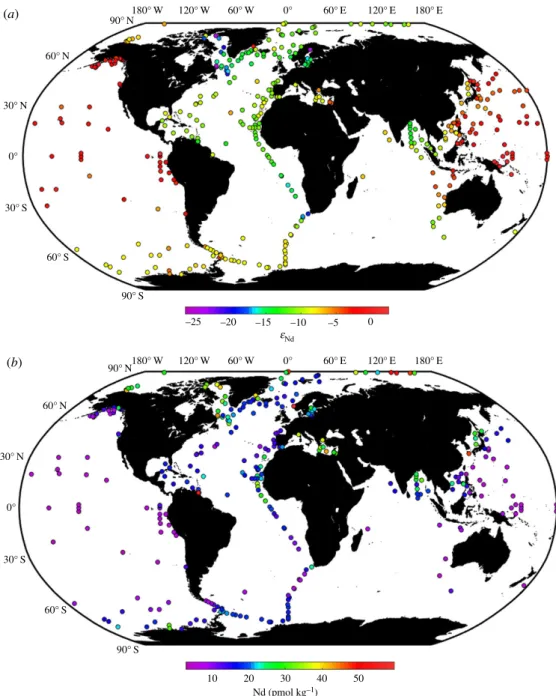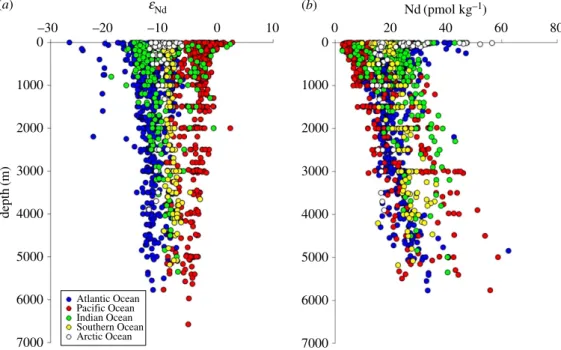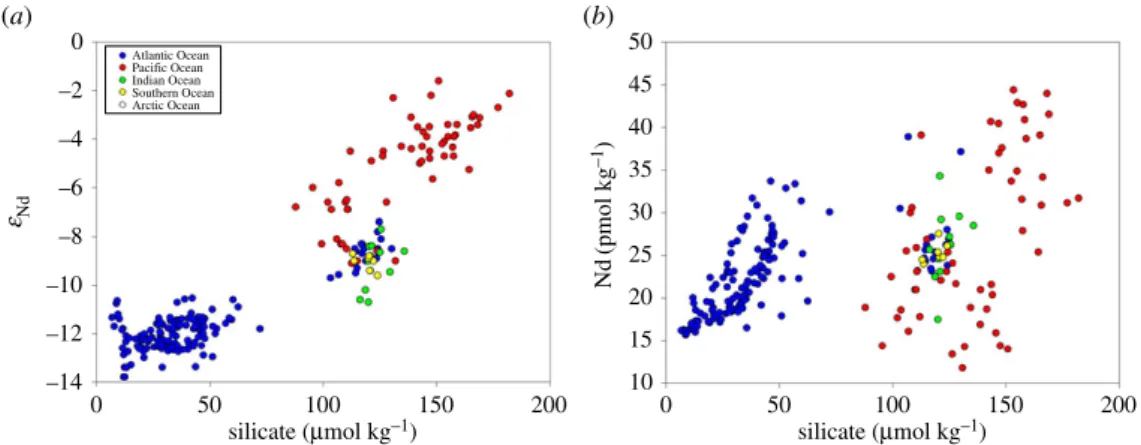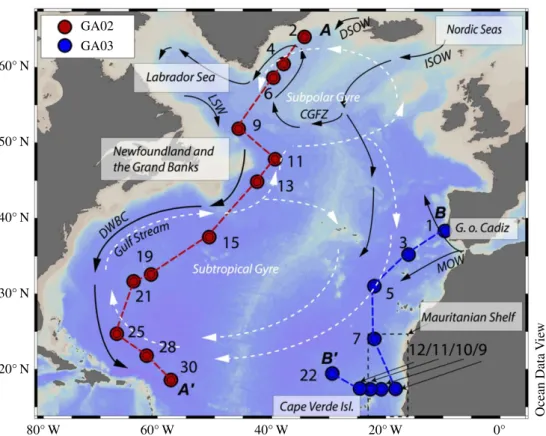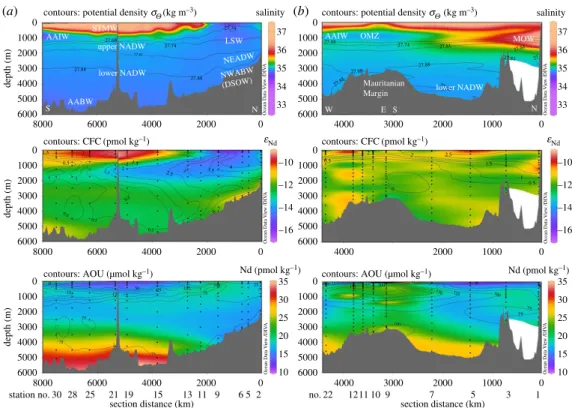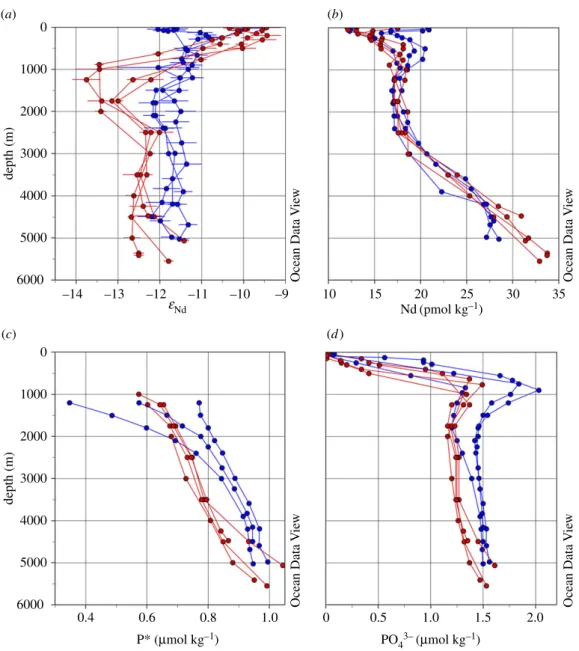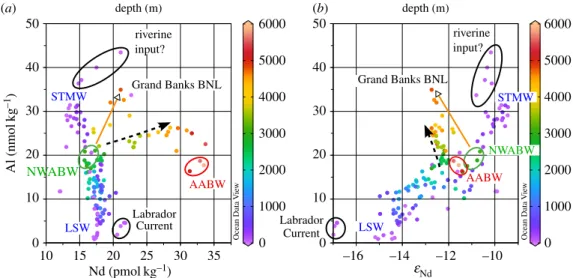We begin by presenting a new global database for Nd isotopes and concentrations in seawater in the context of hydrography and macronutrients through the GEOTRACES International Data Collection Center (and as electronic supplementary material). Together with the growing number of laboratories involved in the analysis of Nd isotopic compositions and concentrations in seawater, this progress reflects momentum. In order to visualize the main features of the Nd distribution in the open ocean, stations with Nd concentrations greater than 60 pmol kg-1 are not shown.
A total of 36 stations were sampled and seawater from nine stations of the first leg in the eastern North Atlantic has been analyzed for Nd isotopes and concentrations and published by Stichelet al. In the subtropical deep Atlantic, both water masses are combined and designated here as lower NADV (Figure 6). For reference, Table 1 summarizes our best estimates for the source compositions of the major mid- and deep-water bodies in the North Atlantic.
Neodymium concentrations correlate well with nutrients in the upper water column, due to Nd adsorption to (organic) particles and subsequent release after remineralization [45,46]. A detailed description of the near-vertical and near-horizontal trends shown in panel A is provided in the main text. In summary, the Nd isotopic compositions of intermediate and deep waters along section GA02 in the western basin trace the water masses (figure 6).
Similar Nd concentration profiles on both sides of the North Atlantic (Fig. 7b) argue against a stronger vertical supply of Nd in the east.
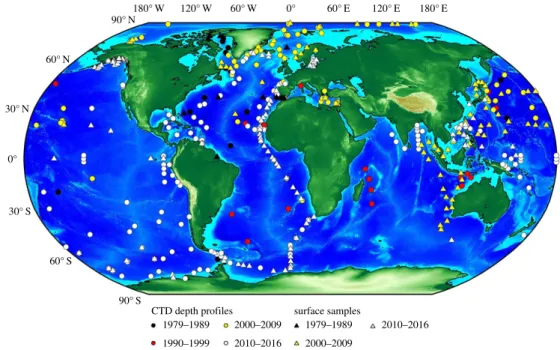
Western and eastern North Atlantic GEOTRACES sections GA02 and GA03
The dominant feature along the western section is the very unradiogenic signature of LSW, which is strongly advected southward into the Deep Western Boundary Current (figure 6). The only water mass in the eastern Atlantic with the potential to create a tongue of distinct Nd isotopic compositions is MOW, which, however, does not show a strong fingerprint away from the Gulf of Cadiz (fig. 6; . see also § 4). Qualitatively, Al concentrations and Nd isotopic compositions in the western North Atlantic section share many features, which are evident in a section of Al concentrations with superimposed Nd isotopic isolines ( figure 9a ).
The distribution of Al in the western basin is strongly influenced by the distribution of the main water masses [109]. Aluminum concentrations and Nd isotopic compositions in approximately the upper 2500 m of the water column show a strong positive correlation (purple to dark green colors in Figure 10b). The main source of Al and Nd in the surface ocean in the subtropical Atlantic Ocean is dust, while Lambeletet al.
In the deep (below 3000 m) subtropical part of the section (stations 15-30), Nd and Al concentrations increase with water depth, while Nd isotopic compositions remain relatively unchanged. In the eastern North Atlantic, the relationship of Nd isotopic compositions with water mass distribution is less well defined than in the western basin [46] (see §3). Aluminum concentrations in the eastern basin are strongly influenced by the presence of MOW, which is a highly Al-enriched source [110].
It is interesting to note that the southward penetration of MOW is better resolved in the Al data (Figure 9) than in Nd isotopic compositions (Figure 6), while the opposite was observed for Northwest Atlantic Bottom Water (NWABW) (i.e. DSOW). However, there is also clear evidence that dissolved Al concentrations are influenced by internal cycles, especially in the (sub)surface layer and near the continental margins. Paradoxically, a similar process has been proposed for Al in the western Atlantic [109], but discounted in the eastern basin [110].
Another interesting observation in the eastern section is the behavior of Al in the Mauritanian BNL. This difference in the behavior of Al in BNL has been observed previously and has been attributed to different concentrations of Si in ambient deep waters. There remains ample evidence that Al may behave largely conservatively, especially in the case of MOW occupation at the depth of the thermocline [110].

Implications from GEOTRACES observations for palaeoceanographic applications
In summary, the Al distribution in the eastern section is more complex to interpret, partly because the seawater Nd isotope signal does not allow simple water mass mapping, complicating a coupled evaluation of the two tracers. However, capture of Al (and Nd) occurs in association with the subsurface peak in biological productivity, and the co-varying (increasing) concentrations of Nd and Al in the deep eastern basin (Figure 11a, dashed arrow) may yet suggest a role for reversible scavenging (or other internal cyclic processes) in deep and bottom water. suggested a hydrothermal origin for the high Al concentrations in the deep eastern basin, but no such hydrothermal source can be invoked to explain high concentrations of Nd in the area. In detail, however, the northwest and northeast Atlantic source waters contributing to NADW are distinct in their Nd isotopic composition [ 48 ]. Table 1 provides an update on the characteristics of the main intermediate to deep waters of the Atlantic Ocean.
Labrador seawater is the most non-radiogenic body of water in the North Atlantic (εNd(ULSW and εNd(LSW), but its density is not high enough to sink beyond intermediate water depths (upper NADW). Even small differences in the Nd isotopic compositions of NADW source waters may become more critical over time, but this scenario is only feasible if LSW deepens significantly compared to today, requiring a realignment of the density structure in the North Atlantic [22].
The new GEOTRACES data discussed in §3 contribute to this debate by clarifying the extent and geographic locations of boundary exchange in the North Atlantic. For example, the NWABW changes by 1.1 εNd units over a distance of approximately 650 km in the Irminger Sea [45]. Overall, water mass advection clearly dominates the Nd isotopic signature in intermediate to deep waters of the western North Atlantic, and Nd isotopic distributions agree well with those of conservative water mass tracers such as salinity, CFCs (Figure 6) or neutral density [45] .
Similarly, a footprint of boundary exchange on dissolved Nd isotopes in the eastern Atlantic section (GA03) was only implicated at two sites [46]: station 9 on the Mauritanian margin, where BNL represents a net source of Nd, and station 12 near the Cape Verde Islands , where there is no accompanying change in Nd concentrations. With the exception of a slightly higher spatial variability in Nd isotopes in the (sub)surface layer of the global oceans (Figure 3), no obvious depth dependence of boundary exchange has yet emerged from GEOTRACES data. Deeper in the water column, Nd concentrations in the depth levels of LSW (upper NADW), MOW and AAIW show a remarkably conservative behavior, an observation also made for dissolved Al concentrations (see §4).
40] used a multiparameter model to deconvolute the relative importance of water mass mixing and vertical cycles on seawater Nd concentrations along a section at 12°S in the Atlantic Ocean. However, away from water mass formation areas in the subpolar North Atlantic, Nd concentrations greater than simple water mass mixing are observed in deeper waters and especially in bottom waters (§§3 and 4), which can tentatively be attributed to reversible flushing. Vertical transport through a reversible uptake process may also play an important role in generating the homogeneous Nd isotopic distribution in the eastern Atlantic Ocean [ 46 ], where advection is slower.
![Figure 12. Time series of Nd isotope reconstructions through the last glacial cycle from Bermuda Rise cores OCE326-GGC6 [13]](https://thumb-eu.123doks.com/thumbv2/123dok_br/17633105.4198371/20.739.98.647.66.381/figure-time-series-isotope-reconstructions-glacial-cycle-bermuda.webp)
Concluding remarks
2016 Deep circulation changes in the South Atlantic since the Last Glacial Maximum from Nd isotope and multispectral records. Planet Earth. 2014 Dynamic intermediate ocean circulation in the North Atlantic during Heinrich Stadial 1: a radiocarbon and neodymium isotope perspective. 1993 Geochemical balance of rare earth elements and neodium isotopes in the oceans. Geochim.
2012 The distribution of neodymium isotopes and concentrations in the eastern equatorial Pacific: water mass advection versus particle exchange. Earth Planet. 2015 Disentangling biogeochemical cycles of neodymium from water mass mixing in the eastern North Atlantic.Earth Planet. 2000 Nd isotopic composition and REE pattern in the surface waters of the eastern Indian Ocean and its adjacent seas.Geochim.
2012 Neodium isotopic composition of water masses in the eastern Pacific sector of the Southern Ocean. Geochim. 2014 Biogeochemical implications of dissolved rare earth elements and Nd isotope distribution in the Gulf of Alaska. Geochim. 1998 Neodium concentrations and isotopic compositions in the eastern Indian Ocean and Indonesian Straits. Geochim.
2012 The hafnium and neodymium isotope composition of seawater in the Atlantic sector of the Southern Ocean. Earth Planet. 1999 A new approach to the Nd residence time in the ocean: the role of atmospheric input. Earth Planet. 2007 Precise determination of the cerium isotopic compositions of surface seawater in the northwest Pacific Ocean and Tokyo Bay.
2008 Modeling the distribution of Nd isotopes in the oceans using an ocean general circulation model. Planet Earth. 2015 Circulation of lithogenic marine particles in the US GEOTRACES North Atlantic transect. Deep-Sea Real. 2014 Neodymium Isotope Geochemistry of Seawater in the Mid-Atlantic Ridge Hydrothermal Plume TAG.
1992 Changes in the vertical structure of the North Atlantic between ice ages and modern times.Quat. 2008 Tracing the Nd isotope evolution of North Atlantic deep and intermediate waters in the western North Atlantic since the Last Glacial Maximum from Blake Ridge sediments. Earth Planet.
